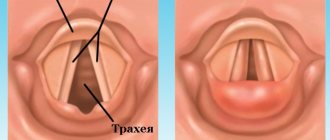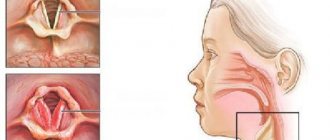Laryngitis is an inflammatory process in the larynx area. The mucous membrane has its own microflora, which protects the body from external factors. This disease often occurs in very young children.
Some circumstances provoke the occurrence of laryngitis, for example, the cause of the disease in an infant may be:
- Screaming (if the baby strains the vocal cords very much).
- Colds (hypothermia leads to decreased immunity, so laryngitis may occur).
- Bad air (constant inhalation of dust or gas vapors has a detrimental effect on the body, including the mucous membrane of the larynx).
- Lack of vitamins in the body.
- Ingress of fungi or viral infection.
- Accompanying illnesses.
If you do not pay attention to the child’s health condition in time and do not apply adequate treatment, laryngitis develops into a chronic form of the disease. Therefore, it is very important to seek help from a pediatrician in time.
Signs of the disease
Laryngitis is a very insidious disease, especially if it appears in newborns. Infants cannot understand what is happening to them, much less explain everything to their parents, but at the same time they feel uncomfortable.
If the disease is treated incorrectly, there is a high probability of false croup, which is dangerous due to compressive symptoms in the larynx. An attack can occur at any time of the day, so if doctors recommend hospitalization, you should listen to their advice.
To prevent complications of laryngitis, it is necessary to recognize the symptomatic picture of the disease in time:
- The child coughs regularly.
- The voice becomes hoarse, and in some cases even rude.
- The baby experiences constant discomfort as pain occurs in the larynx area.
- Nodules may form on the laryngeal mucosa.
In addition, pay attention to the general condition of the child; if the baby does not feel well, he sleeps and eats poorly, and cries most of the time. But even if the child’s health is normal at first glance, the most common runny nose can be one of the first symptoms of the disease.
What should you pay attention to? ↑
Symptoms of laryngitis in infants usually appear suddenly, more often at dawn. Adding to the overall picture is the fear of a child who fell asleep healthy and woke up due to difficulty breathing. The symptoms of the disease are similar to various colds, the only main difference that requires immediate medical attention is swelling of the larynx. Due to the fact that the child’s lumen is small, false croup or laryngeal stenosis often develops against the background of laryngitis, which makes breathing difficult and requires calling an ambulance. Also, the symptoms of laryngitis in infants are as follows:
- a sharp increase in temperature;
- hoarseness in the voice or its complete absence;
- anxiety and restlessness of the child;
- severe dry cough with whistling;
- pain when swallowing;
- pale skin;
- rapid and at the same time difficult breathing of a superficial nature, shortness of breath.
Attention! If the baby's skin around the mouth has acquired a purplish-blue tint, this is the first symptom of suffocation that requires immediate help from a medical professional!
How to treat laryngitis
Drugs for the treatment of laryngitis should only be prescribed by the attending physician; do not self-medicate, even if you have encountered a similar situation before. Parents are required to provide maximum attention to the baby; it is very important to create the most comfortable conditions for the newborn:
- Provide your baby with plenty of warm drinks.
- If coughing attacks begin, place the baby in an upright position and free the chest from unnecessary clothing.
- Do not let your child scream for a long time so that the baby does not strain the ligaments again. Try to distract your baby's attention with toys.
- If possible, humidify the air using a special device, but if there is no financial opportunity, use alternative methods. For example, during the heating season, hang dampened towels on the radiators, place containers of water, or spray the room from time to time.
- Do wet cleaning and ventilate the room regularly.
- To speed up the child’s healing process, perform aromatherapy using eucalyptus, pine needles, fir or juniper oil.
Recently, medicine has been practicing the use of special inhalers , which can relieve the symptoms of the disease in a very short time. If the baby's body temperature rises, the doctor prescribes antipyretics. For advanced laryngitis, the attending physician may prescribe antihistamines or hormonal agents.
If the cause of the disease is an infection, then antibiotics are prescribed, but if the laryngitis is viral in nature, antiviral medications are used for treatment.
Remember that laryngitis is a dangerous disease for infants, since their immune system is not fully formed. It is best that the child is constantly under the supervision of a specialist. But, if for some reason you do not want to go to the hospital, be sure to visit the hospital. Daytime treatment will allow the pediatrician to monitor the baby’s health.
How to recognize laryngitis in an infant
The difficulty of diagnosing laryngitis, as well as any other disease in a child of the first year of life, lies in the fact that a small patient is not able to describe his condition, for example, such obvious symptoms of laryngitis as pain or sore throat that intensifies during swallowing. An important role in how quickly inflammation of the larynx in a baby is recognized and treatment is undertaken depends on the ability of parents to observe the condition and behavior of their child and timely notice any changes in him. So, the following symptoms indicate that the baby may have laryngitis:
- restlessness and moody behavior;
- sleep problems;
- crying while eating or completely refusing to eat (the baby has a very sore throat when swallowing);
- hoarse voice (this symptom can be noticed while crying);
- heavy breathing with wheezing;
- barking cough (has a paroxysmal character, intensifies in the evening or at night);
- temperature increase.
If these symptoms appear, attempting treatment yourself is strictly prohibited. It is necessary to immediately call your local pediatrician.
The danger of inflammation of the larynx in infants is that it very quickly spreads to the trachea and bronchi, and can also provoke stenosis (extreme narrowing of the lumen of the larynx, in which swollen mucous membrane makes it impossible for air to enter the child’s respiratory tract). Therefore, if the listed symptoms are supplemented by fever, chills, increased breathing and shortness of breath, general agitation of the baby, continuous cough, bluish skin, it is necessary to urgently call an ambulance - the child needs emergency care and hospitalization.
The main causes of laryngitis in a newborn baby
In an infant, the larynx has a small diameter, and it is located approximately two vertebrae higher than in an adult. In addition, the vocal folds of a newborn baby are very short, which, together with a fairly narrow laryngeal lumen, even with slight inflammation, can lead to serious difficulty in the respiratory process and even suffocation.
The main insidiousness of the described disease is that such spasms can develop quite suddenly, usually at night.
So that an attack of laryngitis does not take you by surprise, you need to know its main symptoms and actions that need to be taken immediately, you need to know how to treat it.
Quite often, laryngitis in young children is caused by various viral infections. Against the background of diseases such as influenza, the disease manifests itself quite rarely. Often the cause can be dry, polluted indoor air, fairly sudden changes in weather conditions, as well as passive smoking.
Due to the fact that the baby’s nasopharynx is not able to contain a large number of viruses penetrating into it, microorganisms freely descend lower into the larynx. If this causes slight discomfort in an adult, it can become quite a serious problem for infants and children under one year old.
Modern medicine distinguishes the following types of childhood laryngitis:
- Catarrhal;
- Hypertrophic;
- Atrophic.
Before treating the disease, a specialist checks the baby’s body for allergic predisposition.
Laryngitis can be acute or chronic. The latter often develops due to frequently recurring and untreated diseases of the larynx, which are inflammatory in nature, the presence of various chronic foci of inflammation of a particular respiratory organ, as well as recent infectious diseases.
Characteristic signs of the disease in a newborn
Laryngitis in an infant may well develop against the background of perfect health, as well as after suffering a common cold, if it is not treated. It is for this reason that not in all situations the disease can be accompanied by high body temperature.
There are other signs characteristic of this disease in a one-year-old child, which you should know and take appropriate measures immediately when they appear. It is necessary to act promptly, since with laryngitis, infants have a risk of developing swelling of the throat, and suffocation may occur, followed by loss of consciousness.
So, the symptoms of the disease include the following factors:
- The child begins to behave restlessly, is capricious, and has hoarse, rough or silent crying;
- Difficulty breathing in a child and the presence of a gray triangle around the lips;
- Frequently recurring attacks of dry, hacking cough, which many characterize as barking;
- During sleep, the baby has difficulty breathing, air is drawn into the lungs with a whistle, after which a severe coughing attack begins, which resembles croaking.
If an infant begins to choke, if his general condition seriously deteriorates, and breathing becomes difficult, you must quickly call an ambulance.
Before the arrival of specialists, you should perform certain manipulations and follow the following recommendations:
- The child must be raised vertically, freeing the chest from clothing;
- It is important to ensure air flow into the room where the baby is located;
- You can give an alkaline drink, for example, warm, but not hot milk with a small amount of soda or mineral water;
- Moist air relieves laryngeal spasms well, which promotes the effective removal of sputum. For this purpose, you can hang wet sheets in the room and install basins with water;
- Before the ambulance arrives, you can from time to time go into the bathtub, which is filled with steam by turning on the water;
- It is worth trying to distract the baby with toys and, if possible, calm him down.
After examining the child and making this particular diagnosis, doctors, as a rule, take him and the mother to the hospital, where qualified and most effective treatment is provided.
Causes of laryngitis in infants
The main cause of inflammation of the larynx in infants is a viral or bacterial infection that settles on the mucous membrane of the child’s throat. Viruses, bacteria, or combinations thereof cause inflammation of the larynx structures of a newborn or infant.
It should be taken into account that the infection in most cases affects children with weak immunity or underlying diseases that weaken the immunological reactivity of the baby (diathesis, perinatal pathology of the central nervous system, functional diseases of the digestive tract).
Therefore, immune complexes that enter the child’s body during natural feeding are considered an additional factor in protecting the infant. The course and treatment of laryngitis during breastfeeding is much easier, but in most cases it is still carried out in a hospital setting.
Timely determination of the cause of laryngitis in a child under one year of age is the key to proper treatment of this dangerous pathology.
In addition to viral respiratory diseases, manifestations of laryngitis in children under one year of age can occur or be aggravated by insufficient air humidity in the room, lack of ventilation, dust, fungi or other allergens in the room where the child is constantly located.
It is important to remember that in 65% of cases, inflammation and swelling of the larynx in newborns and babies in the first months of life is caused by unsanitary conditions and negligence of mothers, as well as prolonged screaming and/or inhalation of very dry air.
Parents should be aware that the use of aerosols and sprays in children under one year of age (in rare cases up to three years old) causes a reflex narrowing of the glottis and provokes laryngitis.
How dangerous is laryngitis for a baby?
Laryngitis in children and adults begins in the same way: first, coughing appears, then the temperature rises.
But if an adult can suffer the disease “on his feet”, like a common cold, then for infants without adequate treatment it can be fatal.
This disease is especially dangerous for children under six months of age , when the larynx has not yet formed, its tissues are quite narrow, and its elasticity is too high.
In this case , laryngitis can lead to death, although in cases where suffocation is observed, there is a chance to save the child if you call an ambulance in time, and the little patient is taken to the hospital, where he will undergo an emergency tracheotomy (excision of the trachea to provide oxygen access to easy).
First aid for stenosis
It is necessary to call an ambulance, specifying the age of the child. This is necessary for the station to send a competent specialist. At the same time, a set of measures is carried out aimed at stopping the development of edema and preventing complete blockage of air access.
- Keep baby upright.
- Remove clothing from the child's chest and ensure adequate air flow.
- Pour hot water into a basin or bathtub so that the room is filled with steam. Humidifying the air helps relieve spasms.
- Give the child a warm alkaline liquid that reduces swelling (milk with soda or still mineral water).
- Dip the baby's feet and hands in a basin of warm water. It acts as a distraction therapy.
- It is good to soak large sheets and towels in water and hang them around the crib, thus moistening the air.
- If you have a nebulizer, inhalations with saline are carried out at home. If a child has already had a similar attack, then the parents know how inhalations with hormonal drugs are carried out. The dosage must strictly correspond to the age and body weight of the baby.
Note! Laryngitis, accompanied by stenosing attacks, tends to recur in infants. Then the symptoms become more vivid than in the first case. Therefore, seeking specialized help is mandatory even when the attack was stopped independently.
On the part of medical workers, first aid is provided depending on the stage of stenosing laryngitis. In the compensation stage, inhalations are carried out using a Bobrov apparatus or a nebulizer. Oxygen and infusions of chamomile, violet, and plantain (if available) can be used. Add a tablespoon of cough mixture with marshmallow and thermopsis to the warm drink.
Antihistamines (suprastin) or a lytic mixture (pipolfen + aminazine + novocaine) are administered intravenously or intramuscularly. In parallel, antibiotic therapy is prescribed.
The second stage also requires inhalation, however, decongestant mixtures are already used. Here is an example of one of them:
- ephedrine;
- adrenaline hydrochloride;
- atropine;
- suprastin;
- pipolfen;
- hydrocortisone;
- chymotrypsin;
- saline sodium chloride solution.
The doctor prescribes the dosage and time of inhalation depending on the age and body weight of the baby. Eufillin is administered to relieve spasm. In parallel, antibiotic therapy and the administration of antihistamines and hormonal drugs are carried out.
The third stage of false croup requires all the same measures, but the doses of hormonal and antiallergic drugs are increased. Subanesthetic direct laryngoscopy with airway toilet is also performed.
The asphyxia stage requires immediate tracheotomy.











